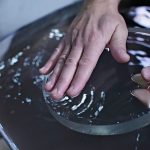Sight glasses make it possible to observe chemical processes in reactors directly or check fill levels inside pipes and storage tanks. These glasses are often exposed to aggressive chemicals, high pressures, elevated temperatures and sudden temperature changes. Borofloat 33 is a borosilicate glass that withstands such extreme conditions exceptionally well.
Sight glasses made of borosilicate glass
Viewing extreme conditions safely
Sight glasses make it possible to observe chemical processes in reactors directly or check fill levels inside pipes and storage tanks. These glasses are often exposed to aggressive chemicals, high pressures, elevated temperatures and sudden temperature changes. Borofloat 33 is a borosilicate glass that withstands such extreme conditions exceptionally well.
Manufacturing processes in the chemical, pharmaceutical and food industries are generally controlled and monitored electronically by state-of-the-art sensors. Nevertheless, additional visual inspections by an expert or surveillance technology are often desired, as they allow more immediate detection and assessment of anomalies that could otherwise cause serious breakdowns and safety problems. However, these key manufacturing processes frequently take place at high temperatures and pressures and involve aggressive media. Normal glass cannot handle such extreme conditions. Speciality glasses are therefore used inside pipes, reactors and storage tanks, and many state-of-the-art sight glasses are made of Borofloat 33 borosilicate glass from Schott.
Otto Schott developed borosilicate glass back in 1887. It proved to be extremely resistant to high temperatures and temperature shocks and was therefore used in three applications: heat-resistant incandescent light cylinders for gas and oil lamps, tanks and reaction vessels for the still-young chemical industry and cookware and similar products. As an international technology company, Schott started producing floated borosilicate glasses in 1993. In this production process, the molten glass floats on top of a bath of molten tin and cools down homogeneously. The surface tension between the tin and the liquid glass creates an exceptionally flat and even surface. One interesting aspect of the float glass method, particularly with sight glasses, is that it enables various glass thicknesses between 0.7 and 25 mm.
“Boron, which gives borosilicate glass its name, is an absolutely crucial element in the glass manufacturing process, as it determines the thermal expansion and the strength of the bonds in the glass network”, explains Christiane Gallo, Manager Applications Logistic Services at Schott.
Increased amounts of silica, a reduction in alkali oxides and the addition of boron trioxide in combination with alumina create a more compact glass network compared to regular soda-lime glasses. For that reason, Borofloat 33 glass offers excellent chemical resistance and exhibits extraordinarily low thermal expansion behaviour.
Special characteristics
“The unique thermal and chemical characteristics are responsible for the great success of our Borofloat 33 glass in sight glass applications”, Gallo adds. Since these glasses are often subjected to elevated or fluctuating temperatures, thermal shock resistance plays an important role for sight glasses. In high-heat applications, the sight glass is heated on the side facing the inside of the pipe or reactor, while ambient temperature is often observed on the outside face. Under these circumstances, the inside and outside of the glass will expand at different rates, causing thermal stress which in a worst-case scenario can prevent the glass from functioning properly. In such situations, Borofloat 33 borosilicate glass greatly benefits from its low coefficient of thermal expansion. With a coefficient of just 3.25 x 10–6 1/K, its thermal expansion is only a third of that of soda-lime glass. This low thermal expansion significantly reduces thermal stress. Borofloat 33 glass can be exposed to temperatures up to 500 °C for a maximum of ten hours or up to 450 °C for even longer periods. However, sight glass users must take into account temperature gradients and pressure differences to ensure material stability. Schott advises end users on how to design sight glasses properly and even calculates the necessary glass thicknesses based on the application temperature and pressure load.
Sight glasses are frequently exposed to high pressures and design measures can be taken to provide them with the necessary resistance. This means that if a sight glass is expected to serve in a high-pressure environment, one option is to decrease the glass surface and increase the thickness. If the design does not permit this, sight glasses made of Borofloat 33 can also be thermally toughened to improve their design strength and allow them to resist higher pressures. In this case, the glasses are heated up to more than 600 °C inside a furnace and then quickly cooled down to room temperature by blowing cold air onto them. As the material cools at different speeds from the outside towards the inside, tensile stress is created inside the glass while compressive stress is exerted on its surface. The overall strength of the glass is increased as a result. This type of thermal treatments additionally makes the material more resistant to thermal shocks and impacts. Schott engineers help customers identify the glass specifications needed for each of their respective applications. Schott does not cut or finish the glass to meet the customer’s needs; instead these tasks are performed by third-party companies such as Schröder Spezialglas, Irlbacher Blickpunkt Glas or GKF, all located in Germany, or Swift Glass of Elmira, New York.
Besides its physical load capacity, Borofloat 33 glass is exceptionally resistant to chemicals and water. It exhibits acid resistance corresponding to class 1 (according to ISO 1776) as well as alkaline resistance A2 (according to ISO 695) and belongs to hydrolytic class HGB 1 (according to ISO 719) or HGA 1 (according to ISO 720). Since chemicals can dissolve alkalis from glass compounds and, in turn, weaken the glass over time, Borofloat 33 is made with a reduced alkali content and boron as a network creator. Glasses without these capabilities can turn matte and break more easily if the surface is damaged.
Soda-lime glasses often contain higher iron impurities, which give the glass its greenish reflection. Borofloat 33 glass, however, is characterised by an extremely low iron content that affords excellent viewing. High transmission and clarity are especially important when processes need to be observed with cameras or laser systems.
www.cpp-net.com search: cpp0315schott
Bernhard Gerl
Bernhard Gerl
Freelance journalist
Share:









